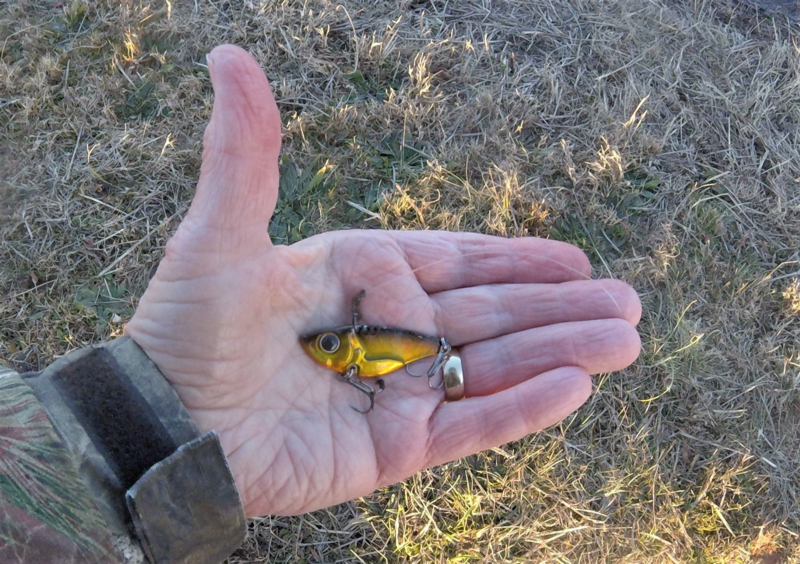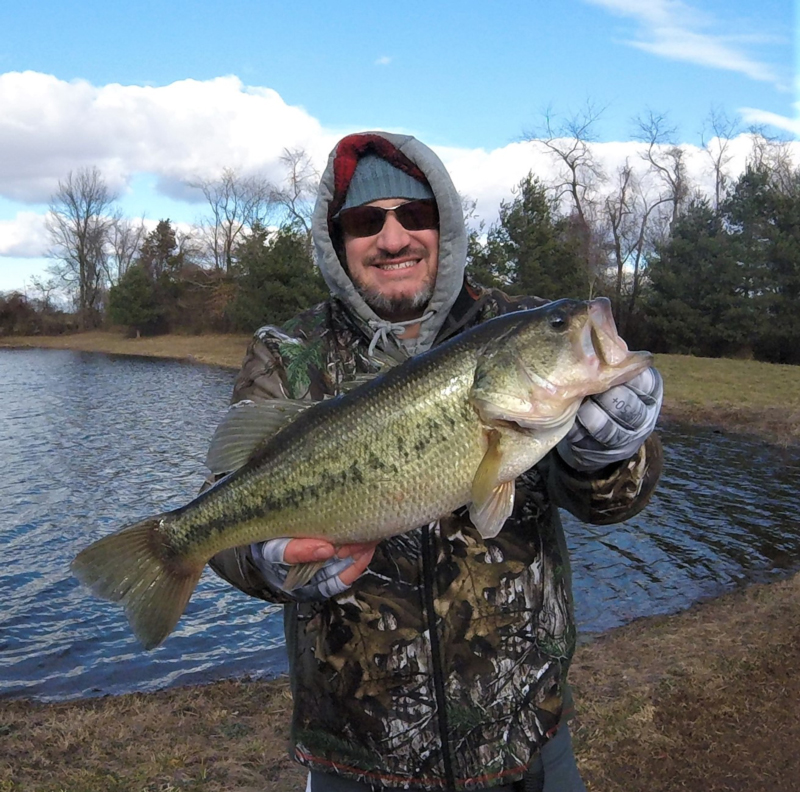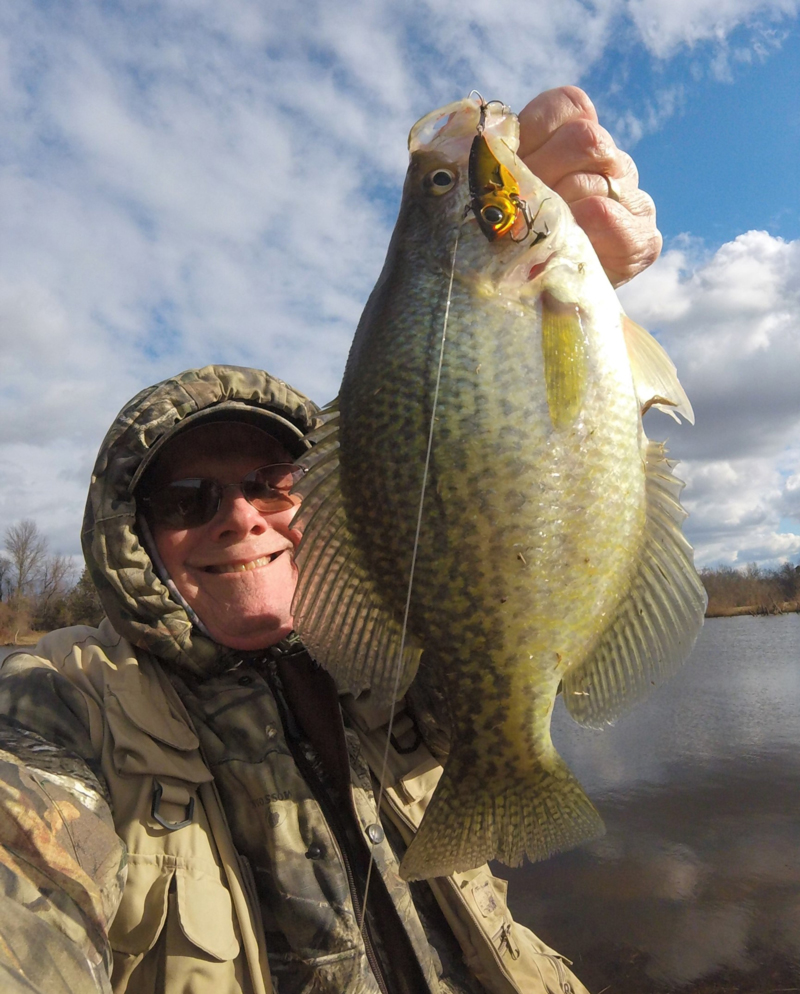Blade baits and largemouth bass in the Mid-Atlantic zone… hmmm. I always thought it was a Mid-South, cold weather Tennessee Valley type of gig for deep-water spotted bass, and maybe some white bass or hybrid stripers. Don’t hear much about them around here, although spoons certainly catch their share of fish, especially in the salt waters. We’ve read about the classic Silver Buddys, and maybe a few others. But the truth is, lots of Mid-Atlantic bass anglers stow the gear once hunting season arrives.

Intrigued, I went out and bought some Buddys, Rapala Rap-V Blades, and the Damiki Vault blade baits in a variety of colors and hues, in half-ounce weights, and gave them a shot last December and January during our mild winter of 2020-21. The blades are thin-pieces of metal, counter-weighted with a soldered or welded lead or tungsten oval to make the lure run in a tight but vibrating fashion, to trigger strikes. Word on the street had it that these lures should be fished with aggressive, sharp snap-jigging motions to get the attention of the bass. But in 40-degree water or even colder? I’ll admit, I had my doubts.
The first trip with the blades was an eye opener. I realized that these lures are traditionally fished in a vertical jigging presentation, usually from a boat, and over a marked school of fish on sonar. Okay, no boat, no sonar, and thus no vertical presentation. I decided to make long casts to the basin areas of some of my favorite ponds and allow the blades to settle to the bottom, then snap them up and then allow them to settle back down on a tight line. To get the feel for lethargic winter largemouth, I utilized a medium light action spinning rod with a sensitive tip but enough backbone to set hooks at a distance. Twenty-pound braid was the mainline and I used a 12-pound clear mono or fluorocarbon leader. These lures come with a duo-lock swivel and I tied my leader directly to it.
Two things became very apparent right off: these lures will cast a mile, and when you put them to work they put out tremendous vibration. Even with the three-foot long fluro leader, I could feel the vibrations of the Damiki Vault literally down to my bootstraps. The longer the cast, however, the tougher it might be to feel a strike. Essentially, I was using a vertical lure for a lateral presentation. Additionally, the continuing “yo-yoing” of these half-ounce baits amounted to some work, and my forearm soon let me know about it.

“Okay, we’re learning,” I thought. “This will take some getting used to, but I think I can chuck these things for a couple hours, during the warmest part of the day, to the deepest areas of a small lake or pond when no one else would even think about fishing on a cold, windy 40-degree day. So, what else is wrong with me?”
My first bite on a blade was what I call a “slack strike,” where a bass is coming in the same direction of your lure travel and overtakes the lure, throwing slack into your line and retrieve. I had felt this sensation before on other lures, so I instinctively set the hook. To my surprise and pleasure I hooked a two-pound largemouth — within the first 30-minutes of using a blade bait. Success! For the next two hours I chucked and tossed and tossed and chucked heavy metal, hooking just two more fish and landing a stout three-pounder. I viewed the initial effort as a huge success and was more than ready for a return trip.
Ahh, the next trip… overcast, windy, 42 degrees and spritzing rain. Great weather for ducks and staying close to the wood stove. Not so much for fishing. But as I often do, I gave it a shot in basically terrible conditions. On my second cast I caught a 19-inch bass that just missed the four-pound mark. This fish, however, pounded the Vault as I lowered it down from a lift off the bottom. It was a hard, heavy strike, with no need for a hookset. In the next 90 minutes I hooked six fish and landed four, including a gorgeous 21.5-inch largemouth that pushed six-pounds. I was stunned and amazed at the effectiveness of these baits and how they seemed to trigger strikes from quality-sized fish in particular. And in the middle of the winter, with 40-degree water temperatures and in absolutely horrid weather conditions, no less.
Subsequent trips with the blade baits showed that most strikes came as the lure was falling back from the sharp, vibrating “up-snap.” Keep a tight line as the lure descends as most of these strikes are heavy and easily transmitted through the rod-tip. Most slack-strikes occurred during the lift process of the retrieve. Often even larger bass would be just barely hooked or even sometimes hooked on the outer portion of the cheek or throat area. We fished mostly during mid-day timeframes when the weather was the warmest of the day. This was easier on us but may not be the best time to fish for the bass. Still in the learning process, we hope to gain more insight and skill this coming winter.

Additionally, we found that the occasional large crappie would bump a blade and give us a variety bonus fish. We had some trips where we only had three or four strikes in a three-hour period. Our best trip of the winter came on a cold, sunny, and blustery January day when we hooked 18 fish and landed 10, including multiple three-pounders. Keep in mind that this was all a horizontal, not vertical, presentation. Boats and sonar may well have put us on many more fish, but we did the foot-patrol gig and had pleasing results.
Keep in mind that smaller blade baits like Reef Runner Cicadas are often the weapons of Mid-West ice anglers who target large crappie, yellow perch, and pike during the ice fishing season. Some other anglers favor them when dock fishing for large white perch and small rockfish. Blades may also catch fish from bridges and docks throughout the winter where open water is available. Our efforts were with lures that were all a half-ounce in weight and seemed to team well with 15- to 20-pound braids.
These experiences are certainly not the final word on the cold-weather blade-bait gig. Your waters and environments may show different patterns. But one thing I do know for sure is that I’m throwing heavy metal for winter bass if there’s no ice cover this winter!
-By Jim Gronaw